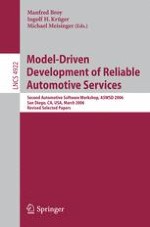Software development for the automotive domain has become the enabling te- nologyforalmostallsafety-criticalandcomfortfunctionso?eredtothecustomer. Ninety percentofallinnovations inautomotive systems aredirectly or indirectly enabled by embedded software. The numbers of serious accidents have declined in recent years, despite constantly increasing tra?c; this is correlated with the introduction of advanced, software-enabled functionality for driver assistance, such as electronic stability control. Software contributes signi?cantly to the - tomotive value chain. By 2010 it is estimated that software will make up 40% of the value creation of automotive electrics/electronics. However, with the large number of software-enabled functions, their int- actions, and the corresponding networking and operating infrastructure, come signi?cant complexities both during the automotive systems engineering p- cess and at runtime. A central challenge for automotive systems development is the scattering of functionality across multiple subsystems, such as electronic control units (ECUs) and the associated networks. As an example, consider the central locking systems (CLS), whose functionality is spread out over up to 19 di?erent ECUs in some luxury cars. Of course, this includes advanced functi- ality, such as seat positioning and radio tuning according to driver presets upon entry, as well as unlocking in case of a detected impact or accident. However, thisexampledemonstratesthatmodernautomotivesystemsbridgecomfort-and safety-critical functionality. This induces particular demands on safety and - curity, and, in general, software and systems quality. The resulting challenges and opportunities were discussed, in depth, at the second Automotive Software Workshop San Diego (ASWSD) 2006, on whose results we report here.
